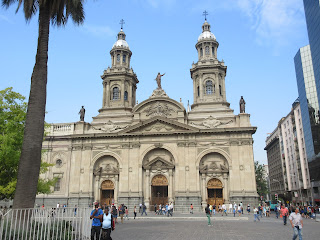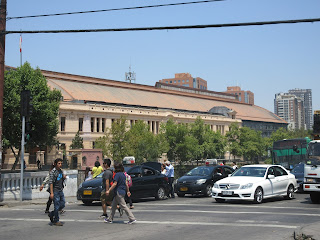I went for a walk around the city centre starting with the cathedral in the Plaza des Armas.
A former palace which is now the main post office.
The Chamber of Deputies until 11th September when the military took over and General Pinoche ruled the country. The chamber now sits in Valparaiso.
The presidential palace and formerly where the mint was housed. When the military took over, the guards inside resisted and it was bombed from the air being it was also taken over by the military.
The Stock Exchange and note the French influence which was a result of a determined effort to move away from their Spanish colonial rulers.The Theatre which was holding a number of cultural events throughout the city for the first three weeks of January.
Casillero Hildago, built in 16th century on top of the Santa Lucia hill in the centre of Santiago. And the view from the top would be pleasant if there wasn't a haze of pollution which hung over the city.
A statue of one of the local Mapuche chiefs who attacked the Spanish city on 11th September 1541 and burned most of it, just seven months after the Spanish founded the city and started building.
There were several cultural events, this was one of the Mapuche inspired offerings. They are keen to preserve their own culture and identity even after several hundred years.
The funicular railway to the top of Santa Cristalbal was under going maintenance so I had to walk up but the view was better than Santa Lucia as it was higher.
Museo del Belles Artes or Museum of Fine Arts built in 1912 to celebrate a century of independence. Not the heavy French influence on both the outside and the inside as a marked departure from any Spanish influence.
A detail of one of the roof supports.A couple of views of the glass roof above the main central area.
And another great building, the front and side of the former railway station. After the military took over, the government invested in raids and let the railway network fade into obscurity. The railways are still suffering and there are no trains now from this station although the fabric of the building has been extensively renovated.
Before I went to have a drink, I tried sopiapillas, some street food made from squash, about the size of a slice of bread, coloured bright yellow and served with a piquant sauce...it fills a hole and is traditional snack food in Chile. Next it was off to a bar and here is the outside of La Piojera, a play on la piojo meaning a louse. It is a bit of a dive but it appears in many guide books as the place to go.
La Piojera is well known for serving terremoto, a small cup of which is shown below. It is white wine with a dash of grenadine in the bottom and a scoop of ice cream in the top. It is the traditional drink served in September to celebrate Chilean independence.
Just virtually next door is the fish market. It became such a popular destination that the central area has been taken over by expensive restaurants and the actual market has been pushed to one side.
A great delicacy can be bought here...king crab but it costs about USD300 for one crab but it can serve six people comfortably. More affordable is to opt for a single leg...it tastes great so it is worth the price if you haven't had it before.
A couple of views of the restaurant area under the main roof.
That evening there was a cycling event...an attempt to promote cycling, reclaim the streets, anti car, encouraging healthy living, a chance to protest and a host of other reasons. It occurs on the first Tuesday of every month and attracts thousands of cyclists and gridlocks the city.
Another local drink option that I tried...this is mote con huesillo, made of stewed dried peaches with a couple of halves of peaches and in the bottom a type of maize.
Then I caught up in a demonstration whilst trying to catch the metro to the main station. The mapuche who make up about 5% of the population but concentrated in the area around Santiago and southwards have resisted dominance and have tried to maintain their own culture and beliefs. Their spiritual leader has been in prison without trail for over three years after allegedly being involved in a firebombing of a landlords house.
The air was full of tear gas drifting around the plaza and down side streets. The ground was wet from various water cannons that were deployed in the area. A couple of riot police vans moving into position.
A water cannon moving around the main roundabout in Plaza d'Italia, the traditional centre where all demonstrations take place.Water cannon being fired into the crowds.
Another demonstrator is forcibly arrested and taken away.
Police lining up for another show of strength and baton charge to grab a ring leader for arrest.
One of the burning barricades which was soon put out by a water cannon.



































No comments:
Post a Comment